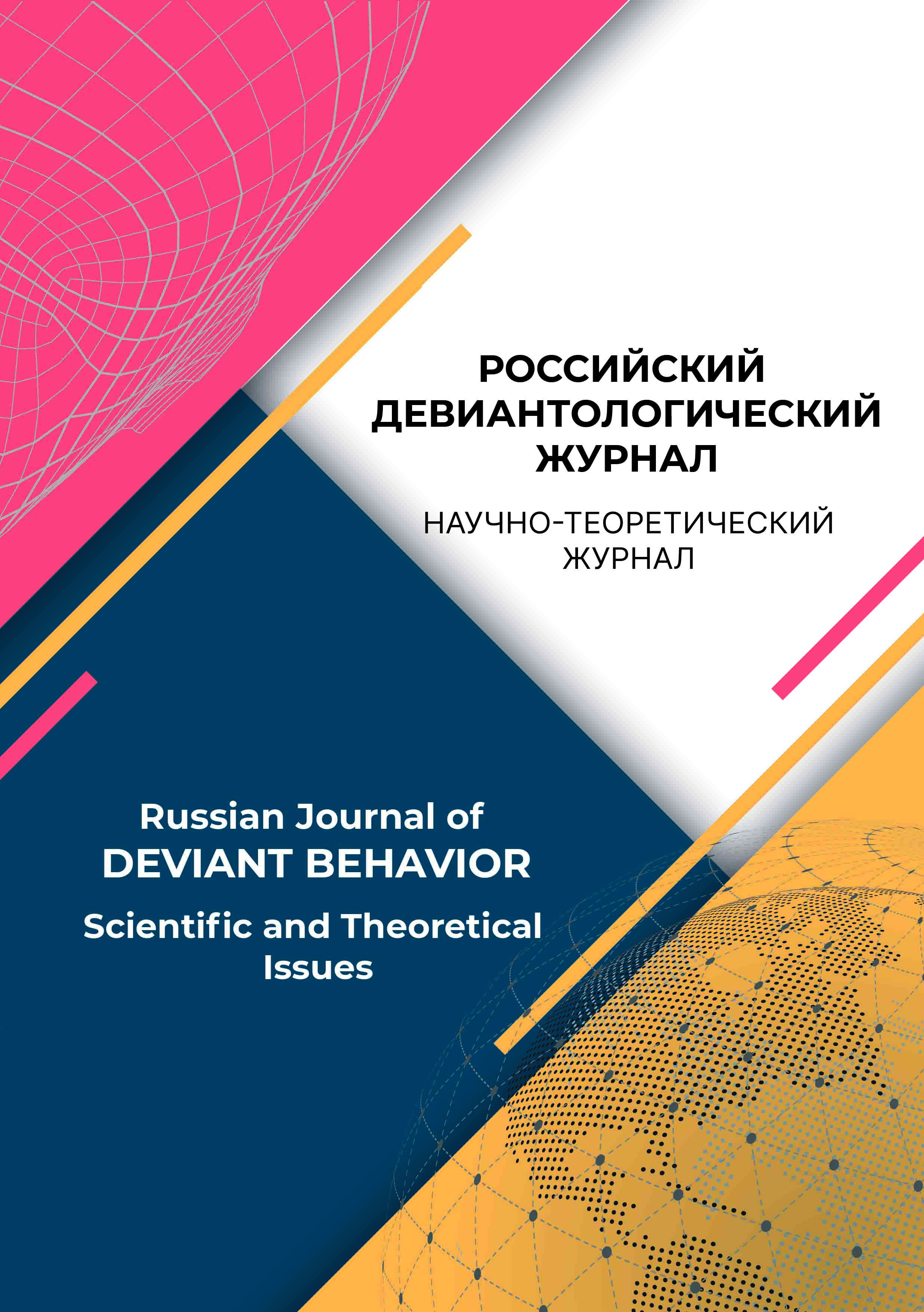Sankt-Peterburg, Russian Federation
The official decline in registered crime rates is associated with a high level of its latency, new forms and methods of its commission, «computerization of crime» and an artificial redistribution of public attention to extremist crime and corruption. Russian crime continues to be self-serving, violent, and organized. A factor of its latency is the problem of the young people’s career placing in the job and low pay for their work. The Internet is actively used by «criminal IT specialists» in drug trafficking, deliberately false reports of acts of terrorism; juveniles and young people are chosen as perpetrators of crimes and as victims of crimes. They are also characterized by participation in the organization of prostitution, illegal arms trafficking, and self-serving violent crimes. The family remains both the factor of juvenile and youth crime, and the main subject of its prevention. The adoption of the criminogenic draft law «On the prevention of domestic violence», the legalization of the drug market and the authorization of the use of methadone in Russia are unacceptable. Prevention of crimes committed by juveniles, young people and their families is a priority, it should be based on the developed state ideology. It is based on morality, patriotism, healthy lifestyle, and law-abiding behavior. A return to the priority of international law is essential. This will preserve the system of prevention and suppression of the most dangerous types of crimes using mechanisms of international control and interaction.
prevention, crime, juveniles, youth, computerization of crime, family criminology
1. Askew, R., & Salinas, M. (2018). Status, stigma and stereotype: How drug takers and drug suppliers avoid negative labelling by virtue of their ‘conventional’ and ‘law-abiding’ lives. Criminology & Criminal Justice, 19(3), 311-327. https://DOI.org/10.1177/1748895818762558
2. Coomber, R., & Moyle, L. (2018). The Changing Shape of Street-Level Heroin and Crack Supply in England: Commuting, Holidaying and Cuckooing Drug Dealers Across ‘County Lines’. The British Journal of Criminology, 58(6), 1323-1342. https://DOI.org/10.1093/bjc/azx068
3. Ladegaard, I. (2018). Instantly Hooked? Freebies and Samples of Opioids, Cannabis, MDMA, and Other Drugs in an Illicit E-Commerce Market. Journal of Drug Issues, 48(2), 226-245. https://DOI.org/10.1177/0022042617746975
4. Leslie, E., & Wilson, R. (2020). Sheltering in place and domestic violence: Evidence from calls for service during COVID-19. Journal of Public Economics, 189. https://DOI.org/10.1016/j.jpubeco.2020.104241
5. Mars, S., Bourgois, Ph., Karandinos, G., Montero, F., & Ciccarone, D. (2016). The texture of heroin: user perspectives on «black tar» and powder heroin in two US cities. Journal of Psychoactive Drugs, 48(4), 270-278. DOI: 10.1080 / 02791072.2016.1207826
6. Windle, J., Moyle, L., & Coomber, R. (2020). ‘Vulnerable’ Kids Going Country: Children and Young People’s Involvement in County Lines Drug Dealing. Youth Justice, 20(2), 1-22. DOIhttps://doi.org/10.1177/1473225420902840
7. Alikperov, Kh. D. (2020). E`lektronnaya tekhnologiya opredeleniya mery` nakazaniya («E`lektronny`e vesy` pravosudiya»). Saint Petersburg: Yuridicheskij czentr.
8. Gavrilov, V. G., Gotchina, L. V., Didenko, V. I., Kovalenko, V. I., Kudin, V. A., Ozerov, I. N., Pol`shhikov, V. P., Sojnikov, S. A. (2006). Vy`yavlenie i preduprezhdenie nezakonnogo oborota narkotikov. Belgorod: Belgorodskij yuridicheskij institut MVD Rossii.
9. Gotchina, L. V. (2013). Molodezhny`j narkotizm v sovremennoj Rossii: sostoyanie i profilaktika. Saint Petersburg: Sankt-Pe¬terburgskij universitet MVD Rossii.
10. Gotchina, L. V. (2014). Mezhdunarodnoe zakonodatel`stvo v sfere preduprezhdeniya narkoprestuplenij, sovershaemy`kh nesovershennoletnimi, molodezh`yu i v otnoshenii nikh. Lex Russica (Russkij zakon), 5(96), 594-606. https://DOI.org/10.7256/1729-5920.2014.5.9460
11. Gotchina, L. V. (2014). Nekotory`e oczenki ponyatijnogo apparata proekta Federal`nogo zakona «Ob osnovakh sistemy` profilaktiki pravonarushenij v Rossijskoj Federaczii». Vestnik Volgogradskoj akademii MVD Rossii, 3(30), 58-63.
12. Danilov, A. P. (2016). Progress kak kriminogenny`j faktor. Kriminologiya: vchera, segodnya, zavtra, 4(43), 64-68.
13. Petrovskij, A. V. (2020). Kommentarij k dokladu «Ugrozy` i istoki zakonoproekta o profilaktike semejno-by`tovogo nasiliya».
14. Smirnov, L. B. (2020). K voprosu o kriminogennosti zakonoproekta o profilaktike semejno-by`tovogo nasiliya v RF. Kriminologiya: vchera, segodnya, zavtra, 1(56), 34-38.
15. Sudakova, T. M., Vasil`eva, M. K. (2019). O nekotory`kh kriminologicheskikh parametrakh obespecheniya antinarkoticheskoj bezopasnosti. Vserossijskij kriminologicheskij zhurnal, 13(2), 223-233. DOI:https://doi.org/10.17150/2500- 4255.2019.13(2).223-233
16. Sukhodolov, A. P., By`chkova, A. M. (2019). Czifrovy`e tekhnologii i narkoprestupnost`: problemy` protivodejstviya ispol`zovaniyu messendzhera «telegram» v rasprostranenii narkotikov. Vserossijskij kriminologicheskij zhurnal, 13(1), 5-17. https://DOI.org/10.17150/2500-4255.2019.13(1).5-17
17. Sukhodolov, A. P., Marchenko, V. A., By`chkova, A. M. (2019). Kognitivnaya model` «rasprostranenie narkomanii». Vserossijskij kriminologicheskij zhurnal, 13(4), 535-546. DOI:https://doi.org/10.17150/2500-4255.2019.13(4).535-546
18. Shvabaue`r, A. V. (2020). Ugrozy` i istoki zakonoproekta o profilaktike semejno-by`tovogo nasiliya. Kriminologiya: vchera, segodnya, zavtra, 1(56), 13-22.
19. Shestakov, D. A. (2020). Kriminogennoe zakonodatel`stvo v svete semejnoj kriminologii (o proamerikanskom zakonoproekte «O profilaktike semejno-by`tovogo nasiliya v Rossijskoj Federaczii»). Kriminologiya: vchera, segodnya, zavtra, 1(56), 24-29.
20. Shestakov, D. A. (2010). Pochemu by` ne likvidirovat` narkobiznes? Teoretiko-kriminologicheskij podkhod. Kriminologicheskij zhurnal Bajkal`skogo gosudarstvennogo universiteta e`konomiki i prava, 1, 30-34.














